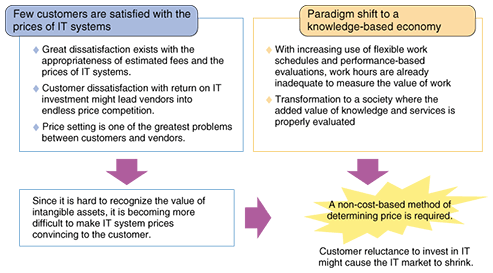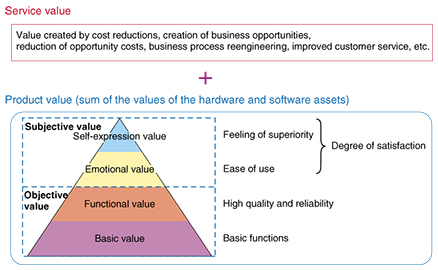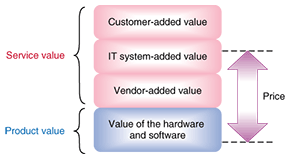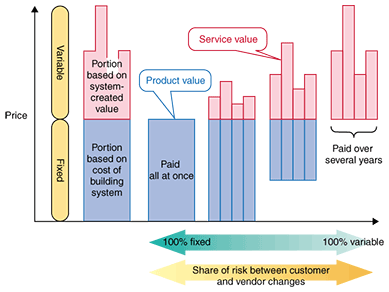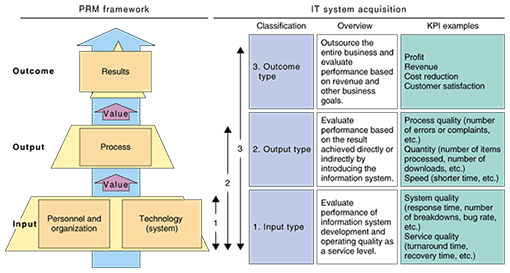 |
|||||||||||||||||
|
|
|||||||||||||||||
|
Special Feature: Knowledge Creation Design Methodology for Service Innovation Vol. 6, No. 7, pp. 10–15, July 2008. https://doi.org/10.53829/ntr200807sf2 Method of Determining the Value of an Information Technology SystemAbstractThis article describes a method of evaluating information technology (IT) systems on the basis of enterprise value using corporate evaluation methods by dividing the system's value into the value as a product (i.e., liquidation value) and value as a service (going-concern value). It could answer growing concerns that customer dissatisfaction with the price of IT systems could cause the IT market to shrink.
1. IntroductionIt is often said that many companies are not satisfied with their return on investment in information technology (IT) systems. A survey of Japanese enterprises conducted by the Ministry of Internal Affairs and Communications in January 2005 [1] found that only 5% of respondents said they had received sufficient return on their IT investment. Even when we add in those respondents who said there was at least some return on their investment, the figure is only two-thirds of the total. Considering that IT investment in Japan is reported to be ¥10 trillion, we must admit that it is a problem if a significant amount of it has been wasted. Dissatisfaction with the return on IT investment is also reflected as dissatisfaction with the price of IT systems. According to the Enterprise IT Trends Survey conducted by the Japan Users Association of Information Systems on IT system user enterprises [2], [3] each year, the appropriateness of estimated fees and the prices themselves ranked highest among the aspects that customers were dissatisfied with. The problem with price setting, however, is not a problem facing the IT industry alone. Even among executives in a wide range of industries in North America and Europe, price is considered the main marketing issue [4]. It is easy to understand that it is difficult to recognize the value of intangible assets such as software. Moreover, in Japan in particular, software has been regarded as no more than an extra accompanying hardware. It is only recently that software has been recognized as something that has value of itself. Therefore, it is understandable that Japanese companies have difficulty in judging a reasonable price for an IT system. However, the time has come when the price problem needs to be solved soon; otherwise, the market could shrink. 2. Breaking free of man-hour costsIn Japan, fixed-price contracts based on pre-determined labor costs, which are estimated from development hours using data determined according to scale and function-specific scale, are often used for the acquisition of IT services. Although it is possible that this pricing method has been used in the IT service contracts for so many years because it is reasonably rational, it tends to demotivate IT vendors because it does not reward them for developing high-quality or high-performance software. As a result, customers too are not necessarily satisfied with the work of IT vendors. In 2006, the Ministry of Economy, Trade and Industry announced that one goal of the Information Service and Software Industry Reform [5] would be for a new pricing method to be widely accepted in IT service contracts in the near future. In an age when there is a paradigm shift to a knowledge-based economy and greater use of flexible working schedules and performance-based evaluations, working hours are already an inadequate means of measuring the value of work. In addition, determining price based on the supplier's cost is somewhat incompatible with the idea of a customer-centric society to which social systems and ways of thinking are themselves shifting (Fig. 1).
3. Value of IT systemsA company would be satisfied with its return on investment if the total customer value exceeded the total customer cost (Fig. 2). One way that is often used to maximize the difference between these two is to decrease the perceived cost by cutting the price. If one goes too far in cutting the price, however, it causes the market to shrink and sends negative signals to the customer. Another way to maximize the difference is to enhance the perceived benefit. For this purpose, I propose considering the value structure of an IT system.
If one thinks of an IT system as a combination of hardware and software, then the value of the system is the sum of the individual values of the hardware and software as independent products. On the other hand, if one thinks of an IT system as a service, the value of the system is more than the sum of the values of its components. The difference comes from the value of the service (Fig. 3 [6]). The service value occurs from using the system and increases over time.
Service value may be considered as the value created by cost reductions, creation of business opportunities, etc. due to the use of an IT system over the lifecycle of that system. It is measured by discounted cash flows generated by the use of the system. In cases where the risk is great, the use of techniques such as the Monte Carlo method or real options analysis may be considered. If the business already exists, one can compare it with a scenario where the IT system is not implemented and assume that the increase in revenue, etc., is the created value. On the other hand, product value may be considered as the value of the hardware and software assets. In other words, put in terms of enterprise value, service value corresponds to the going-concern value and product value corresponds to the liquidation value. When a company is planning an IT investment, it is reasonable to make the investment if the expected service value is positive. 4. IT system priceNext, let us use the same thought process to consider the price. Determining price based on value is a pricing method that might be considered in place of the cost-based pricing. One advantage of value-based pricing is that a good relationship between the customer and vendor is easier to be build because maximizing the value is the common target for both of them. However, since the service value is the value that the customer and vendor jointly create using the IT system, it is necessary to decide how much of that should go into the price, which is the value captured by the vendor (Fig. 4). Note that although some people consider that the value that can be obtained by the customer from a service is the sum of three values—product value, service value, and customer-added value, I consider customer-added value to be included in service value because service is the effect of the provider and customer jointly creating value.
For example, in the case of full outsourcing, the IT system and the vendor basically create the entire value, so it would be appropriate to consider the entire service value as the value standard for determining the price. However, since IT system implementation usually accompanies business process reengineering, the customer is greatly involved, so dividing the service value up between the customer and vendor is appropriate. There is no particular rule regarding what percentage to allocate; it should be determined based on the degree of contribution. It also varies depending on who bore the cost of building the system—the customer or the vendor. When determining price based on value, it is possible to determine a price based on a pre-calculated service value, but there is also a method that allocates created value following predetermined rules depending on a result evaluation. This method is called a performance-based contract. For example, by being combined with the cost of building the IT system to be paid at a fixed price over multiple years, a fixed percentage of the profit realized is to be paid over the lifecycle of the system (Fig. 5). In this case, the fixed portion of the price accounts for the product value, while the variable portion of the price accounts for the service value.
By altering the proportions of the fixed and variable elements, we change the proportion of risk shared by the customer and vendor. Looked at this way, the fixed price contract would be considered to entail a payment of 100% of the fixed price in one payment. A contract in which the cost of building the system is paid in installments combined with the service value has the advantage to the customer of making investment easier for a smaller initial investment. It also has the advantage of building a long-term relationship between the customer and vendor. When determining the price based on performance, it is possible to factor out the impact of unpredictable environmental changes, such as the economy and state of competition, but this increases the burden of risk to the vendor compared with determining the price in advance, so this point needs to be considered. When determining the price after the fact, there may be times when one evaluates not only the ultimate results but also processes and other factors. In this case, one can use the Performance Reference Model (PRM) [7] announced by the Ministry of Economy, Trade and Industry in March 2005, which is similar to the PRM of the Federal Enterprise Architecture of the US Office of Management and Budget. PRM refers to a model that gathers different indicators to objectively evaluate the benefit of information investment. It includes general-purpose key performance indicators (KPIs) and methodologies such as measuring procedures, measuring frequencies, and monetary value conversion methods for each KPI. PRM KPIs are classified into KPIs for evaluating input, output, and the final outcome depending on the qualities of the IT system, and PRM is useful for choosing the KPIs that are subject to evaluation (Fig. 6).
5. ConclusionThis article presented the idea that the value of an IT system consists of product value and service value. The generally used pricing method, which is a fixed price based on estimated labor hours, is inadequate because it evaluates the IT system as only a product. To judge the value of an IT system properly, it is necessary to recognize that such a system has value as a service. One can judge the service value of an IT system through using it and properly chosen performance measures are helpful for evaluating it. Although this article has discussed only the value for customers, IT systems have another value to the developer, i.e., the programmer, besides the accumulation of know-how. That is the joy of creation. Software used to be made with a high degree of craftsmanship, and the spread of open source software brought by the spread of the Internet is said to have given programmers a sense of joy in participating in the borderless community of programmers. Such value for the programmer cannot be measured as trade value. It is an unsolved value and will be the topic of future research. References
|
|||||||||||||||||








